Can violets be transplanted in autumn and when is it better to carry out this procedure?
Saintpaulias, or violets, do not lose their popularity among flower growers. And all this thanks to the variety of varieties that delight breeders. You can create a mini flower bed of flowers of various colors and shapes by planting only one violet. But plants require careful maintenance and comfortable conditions for year-round flowering.
Transplanting indoor plants is a necessary procedure. This allows not only to rejuvenate the plant, but to save it from diseases and pests. But an incorrectly carried out transplant can negatively affect the condition of the flower. Let's consider in more detail whether it is possible to transplant a violet in the fall or during flowering, and when it is better to do it.
Content:
- The best varieties of violets, their features
- Can a violet be transplanted in the fall?
- When is the best time to transplant a flower?
- When is transplantation prohibited?
- Can Saintpaulia be transplanted during flowering?
- How often should the plant be replanted?
- Cooking a container for violets
- Soil requirements
- Violet transplant with complete soil replacement
- Transplant with partial soil replacement
- We transplant using the transshipment method
- Post-transplant care tips
- The consequences of an incorrect transplant
The best varieties of violets, their features
It is difficult to choose from a variety of varieties that flower that will suit the conditions of a house, apartment and which will delight with its unique appearance. Among violets there are many species that are already known and gained popularity:
| Variety | Description of the flower | Features of the |
| Beautiful creole | On a small rosette of green leaves, velvety flowers of a dark blue tone are collected. A white stripe runs along the edges of the petals. | The variety is unpretentious and blooms for a long time. |
| Marshmallow | Large semi-double petals are distinguished by a white-pink color. The rosette of leaves is compact and lush. | Reaches rapid growth and flowering, requires proper care. |
| Pauline Viardot | The wine shade of the petals is combined with a white border around the edge. The inflorescences are arranged vertically. The leaves are dark green in the middle, whitish at the edges, collected in a compact rosette. | Flowering depends on care. |
| Magenta | The variety has large flowers of double and semi-double type. The color of the buds is red-burgundy with a white border around the edge. Light green leaves are collected in a small rosette. | Water the plant through the pallet. |
| Winter smiles | Pink semi-double petals with fringes along the edges of a light green color. Flowers reach 6 centimeters in diameter. Leaves are elongated, quilted. | The plant blooms luxuriantly and profusely, unpretentious in care. |
| Ming dynasty | The violet has a bowl-shaped pinkish petals. Leaves are green, variegated, with wavy edges. | One of the unpretentious plants, easily tolerates adverse conditions. |
| Chanson | The flower consists of many dark blue petals.Light and dark pink spots are visible on slightly wavy petals. The large rosette consists of smooth shiny green leaves. | It blooms luxuriantly and profusely. The variety is distinguished by long flowering. |
The decorativeness of Saintpaulias is not only in the beauty of the buds, the structure of the petals, but also in the leaves. They are also varied in color. Variegated varieties are often found, with wavy edges, velvety or smooth surfaces.
Can a violet be transplanted in the fall?
It is known that violets are grown for their flowering. Only with buds will the plant become a true decoration of the home. An important condition for long and abundant flowering is to transplant the plant into another pot. Indeed, over time, the soil in the pot loses its nutritional value. And without a transplant, the flower can decay.
The time for transplanting is chosen depending on the growing season of Saintpaulia.
After the summer heat, violets feel great, ready to bloom. At this time, there is enough light for them. But in order for them to bloom magnificently, you need to change the soil to a new one or add nutrients to the old one. In the fall, a transplant can be carried out. But this should be done in early September, until the buds appear.
If you transplant a violet in the fall, then in a month it will bloom. Both renewed and rejuvenated, it will present with lush and bright buds. You can transplant a violet in the fall, but before flowering.
When is the best time to transplant a flower?
For indoor violets, the best period for changing the pot and soil will be spring. But autumn is also suitable for transplanting. During these periods, the plant will have enough strength to adapt to new conditions, survive stress and get stronger.
If the procedure was successful, the plant will need 10 hours of daylight hours. In spring and autumn, the flower of light is just enough to survive the changes in your life. And the air temperature will average 18-20 degrees Celsius.
You can see the urgency of the Saintpaulia transplant by:
- stretching and exposing the stem
- soil compaction in a container
- white bloom on the soil surface
- brown leaves
- braided by the roots of an earthen coma in a pot
It is best to replant the violets every year to keep the plant feeling good and blooming for a long time.
Useful video about transplanting violets:
When is transplantation prohibited?
The rules for growing indoor plants indicate that violets cannot be transplanted in summer and winter. The reason for the ban is that in winter the plant does not have enough light to gain a foothold in the new soil. Saintpaulia will not be able to get enough heat, as often the air temperature in winter becomes lower than optimal.
Summer transplant will lead to the fact that the violet will not rest properly and will not gain strength for active flowering. In summer, the air temperature in the room rises, it is necessary to shade the flowers standing on the windowsills so that the leaves do not burn.
An urgent transplant is carried out at any time if the flower is threatened with death from disease or pests.
It is forbidden to transplant a flower during the flowering period. Then you will have to stop the growth of violets, budding. The plant will stop flowering and come out of the "depression" only the next year.
Can Saintpaulia be transplanted during flowering?
There are several reasons for the impossibility of transplanting violets during the flowering period:
- The buds on the plant indicate that the plant is doing well. You can wait for the flowers to wither to carry out the procedure.
- Saintpaulia spends her vitality, nutrition, on the formation of buds. Changing the container will cause the plant to weaken and die.
But in the case when time does not stand, and an urgent transplant is required for the indoor flower, then the buds are cut off and the procedure is carried out.
How often should the plant be replanted?
The peculiarity of the violet is that the flower grows quickly. In order for the root system to be comfortable and have enough nutrients, it is necessary to repot the plant frequently. This is done annually. And it is best to carry out the procedure every 7 months.
Violets are transplanted every year, but in some cases and more often as needed.
The reason for the frequent transplanting of Saintpaulia may be that the flower does not have enough nutrition. The soil is depleted over time, and even top dressing is not able to improve the structure of the soil in the pot. Often, from abundant moisture, the soil becomes dense, covered with a white bloom. Then you can transplant the plant by replacing the topsoil. If Saintpaulia is affected by infection or pests, it is better to change the container to a new one. The soil and pot must be disinfected.
Cooking a container for violets
The flowering of a houseplant depends on the diameter of the pot. The container must be of optimal size. Usually they look at the size of the outlet, choosing the diameter of the container 5 centimeters larger.
In height, the container should not exceed 10 centimeters for medium-sized plants, and for miniature plants, 5 centimeters are enough. The diameter of the pot should be 1-2 centimeters less than its height.
It is necessary to select the capacity of the violet according to the requirements, otherwise the plant will not bloom.
Flowers feel comfortable in plastic or ceramic vases. There must be holes at the bottom of the container to drain excess water into the pan. Through them, the soil in the pot will be better ventilated.
Soil requirements
The soil substrate for Saintpaulias is either store-bought or prepared with your own hands. The main thing is that it is loose, well permeable to air and water:
- The mixture should contain leafy soil, turf, peat or humus.
- For the looseness and lightness of the substrate, coarse sand and charcoal are needed.
- You can add vermiculite, which makes the soil more permeable.
To exclude the infection of the plant with a fungus, the soil is disinfected. For this, watering with a pink solution of potassium permanganate or calcining in the oven is used. Disinfect the soil 2 weeks before transplanting. You can replace the soil in the container partially or completely.
Violet transplant with complete soil replacement
Completely change the soil for violets when the old soil is depleted, in it increased acidity... The contaminated mixture must also be completely changed:
- The new container for the plant is disinfected. To the bottom lay a drainage layer in the form of expanded clay, crushed stone. Then fill the pot two-thirds with soil.
- From the old container, pull out the plant. To make the procedure easy, do not forget to moisten the soil. Water the violet at the root.
- Putting the flower on an oilcloth, examine the roots of the violet, cutting off the damaged and dry ones. The lower large leaves can also be removed. The sections are sprinkled with crushed activated carbon.
- The plant is placed in the ground of a new container and the substrate is poured, leaving 2-3 centimeters to the edge of the pot. Slightly compact the soil.
Completely replace the soil annually in adult plants.
Transplant with partial soil replacement
When compacting the soil in a pot, you can remove the top layer and add fresh soil. Partially replace the soil when the earthen lump formed near the roots is not removed. They select a pot for the plant, pour drainage and a little fresh substrate.
This method is used when transplanting in autumn and summer.
Carefully transfer the plant to a new container, being careful not to damage the roots along with the earthy clod. It remains to add loose soil and slightly compact the top layer. A plant with partial soil replacement will feel better, adapt faster.
We transplant using the transshipment method
For the transshipment method, a new container is prepared, with a larger diameter than the old one. Expanded clay and a little nutrient mixture are poured into it. A container with a violet is placed in a new pot and the gaps are filled with soil, tamping tightly. It remains to pull out the flowerpot with the violet. Then carefully from it - Saintpaulia and place it in the formed recess of a new container.
It is important to fill up the soil so that the root collar is at ground level. The plants are overturned when it is necessary to transplant it during the flowering period.
Post-transplant care tips
Competent care will help to survive the stress after transplanting a violet:
- The plant needs warmth, so the temperature in the room is kept within 24 degrees.
- Do not put the pot in the sun to protect the plant from burns.
- Water the saintpaulias through the pallet. You can put moss or pebbles on it, constantly wetting them with water. The first 3-4 days are not watered so that the plant grows stronger.
- Violet leaves are afraid of moisture. It is impossible to spray the transplanted plant, but only to wipe the leaves from dust with a damp cloth or soft cloth.
It is easy to care for the transplanted violet. It easily takes root when creating a comfortable environment.
More information on how to transplant a violet during flowering can be found in the video:
The consequences of an incorrect transplant
When, after transplanting, the plant begins to dry out, and after a month no buds appear, it means that the procedure was carried out incorrectly.
- If the pot is chosen too deep, then the violet will direct its forces to the growth of the root system. Then you can't wait for the buds.
- The deepening of the socket is also a mistake. In this case, the root system will grow downward, which will lead to a stop in the development of the aerial part. With a high location of the root collar relative to the ground, it will loosening.
- It is impossible to pour water into the center of the outlet before planting, otherwise root decay and the death of the flower will begin. You can water the violet under the root so that the water does not get on the leaves.
- Too dense soil will not allow the roots to receive sufficient nutrition. The development of the violet will stop and the plant will begin to wither. It is necessary to ensure that the soil in the pot is not infected with nematodes, larvae of harmful insects, spores of pathogenic fungi. If the soil is not disinfected, then the violet will begin to ache, its leaves will dry up, and the buds will fall off.
Violet transplant - an important procedure that must be carried out on time and competently. In order for the best varieties of Saintpaulia to please with their long and lush flowering, it is necessary to decide on the timing of the transplant.






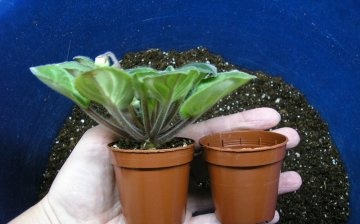
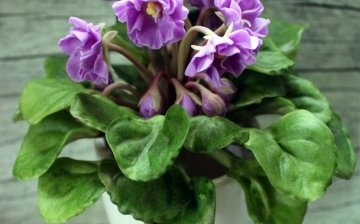

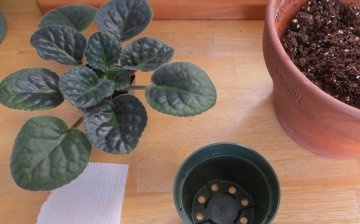
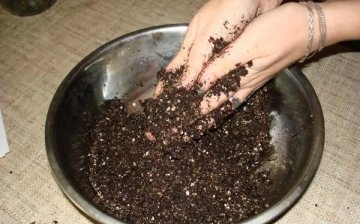
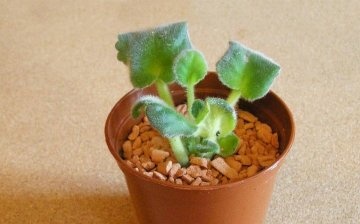

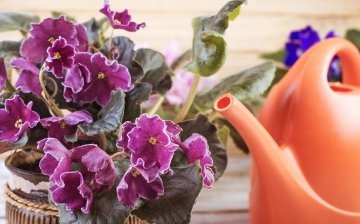











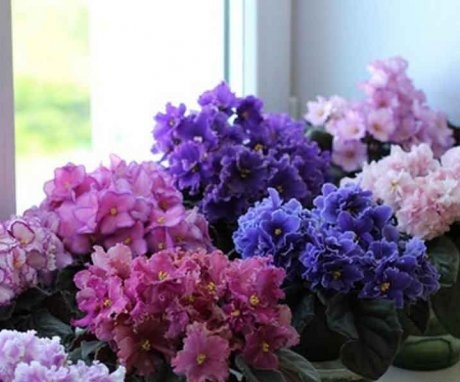
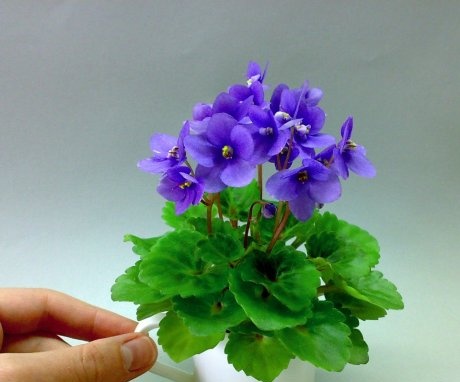
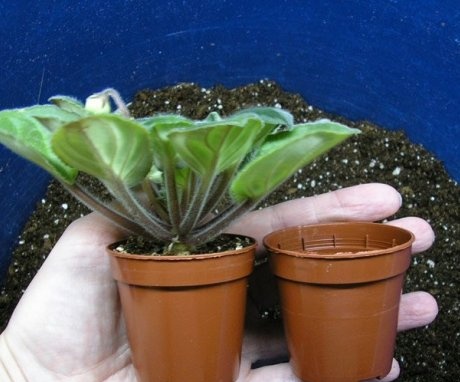
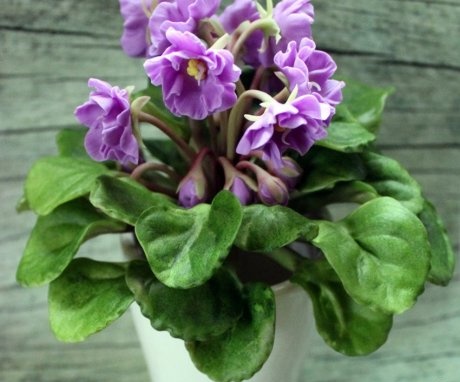

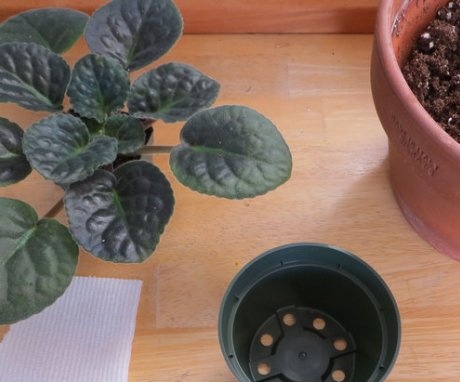
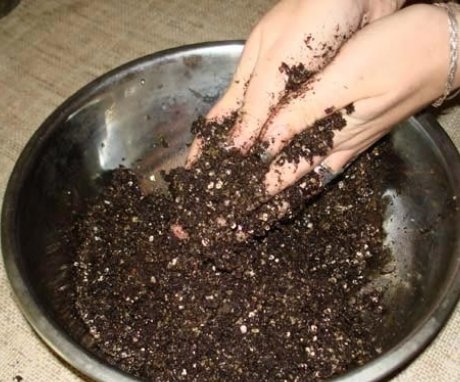
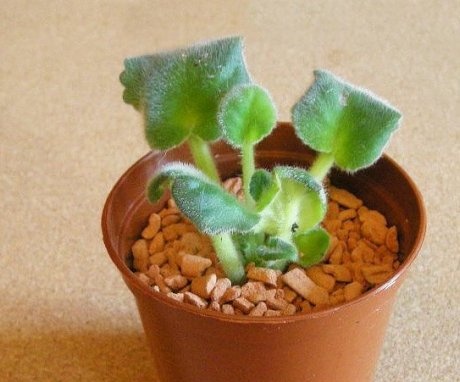
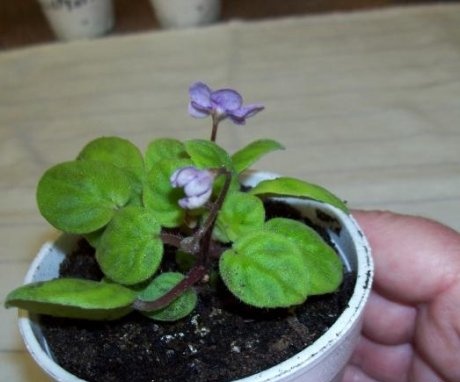
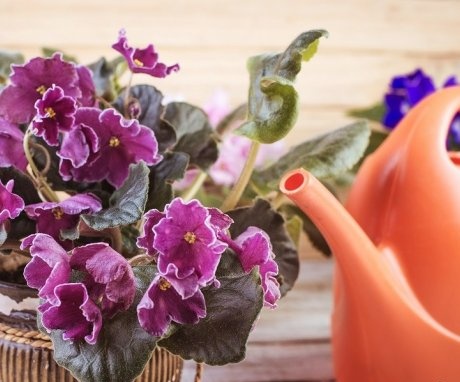
We have a lot of violets, but for some reason they bloom very rarely, I don't even know why this is happening, it is useless to transplant, it did not help us, although we bought a special soil for violets.
I transplant violets only by weight, with partial replacement of soil. They delight with flowering from the beginning of summer until winter, so in the fall in bloom, I do not disturb them. After transplanting, new leaves are quickly formed and the plant becomes lush.
It is best to replant violets in spring and summer. In early fall, in September it is still possible, but later not desirable. They are less well accepted, and they may die. I do not disturb my own in the fall, let them winter calmly.
It is best to replant violets in spring and summer. In early fall, in September it is still possible, but later not desirable. They are less well accepted, and may perish. I do not disturb my own in the fall, let them winter calmly.
Violets are among the most unpretentious indoor plants, they have withstood many of the most daring experiments. Even in February, the plant was successfully transplanted, as the ground began to be covered with a crust after irrigation with poor tap water.
I have a large number of violets, I always breed them with leaves - it's not difficult. And I transplant violets only in the spring. I take a small pot, it is better wider, but not deeper. I buy ready-made soil for Saintpaulias, I definitely put expanded clay on the bottom. Violets grow quickly. After 2 weeks I feed them with Fertika Lux fertilizer.
We usually transplant violets in September, at the very least, in early October.
We definitely try to replace the "weakened" soil, sometimes we just fill it up and update it.
As a rule, the buds after transplantation become even and strong.
I always transplant violets in the spring into a universal soil, I also add perlite. Previously, I just planted it in the ground and everything was fine too. In general, I consider violets to be unpretentious flowers.